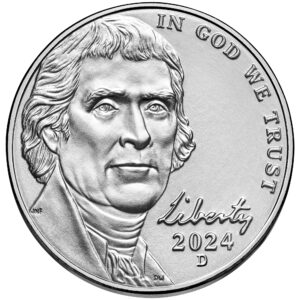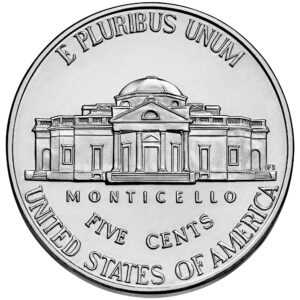The nickel is the United States’ five-cent coin. The person on the obverse (heads) of the nickel is Thomas Jefferson, our 3rd president. He’s been on the nickel since 1938, although the current portrait dates to 2006.
The building on the reverse (tails) is called “Monticello.” Monticello was Jefferson’s home in Virginia, which he designed himself. It has been on the nickel since 1938, except for a brief period in 2004 and 2005.
Nickel History
We know the five-cent coin as a nickel, but it wasn’t always so. The first five-cent coins were made of silver, not nickel. In the Mint’s early days, all coins had to be made of either gold, silver, or copper.
The first five-cent coin in 1794 was called a half dime. It was much smaller than today’s nickel.
The five-cent coin we call the nickel was created in 1866…but the Mint kept making the silver half dime until 1873. So both kinds of five-cent coin were circulating at the same time. The new nickel was larger than the silver half dime and easier to handle.
A woman symbolizing liberty was used in different poses on the five-cent coin until 1913. From 1913 to 1938, the Mint made the “Buffalo” nickel which showed an American bison on the reverse. The bison was the second animal, after the eagle, to appear on a U.S. circulating coin.
In 1938, President Thomas Jefferson appeared on the obverse of the nickel. The Mint changed his portrait in 2005 during the Westward Journey Nickel Series. His portrait changed again in 2006. This time, Jefferson faced forward for the first time instead of the usual right-facing portrait.
Monticello, Jefferson’s home, was on the reverse of the nickel from 1938 to 2003. In 2004 and 2005, the Westward Journey Nickel Series brought four new reverse designs. The new nickels celebrated the Louisiana Purchase and Lewis and Clark Expedition, which happened during Jefferson’s presidency. In 2006, the reverse design went back to showing Monticello.
Learn about other circulating coins.
Penny | Dime | Quarter | Half Dollar | Dollar


